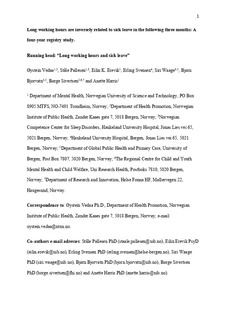Long working hours are inversely related to sick leave in the following 3 months: a 4-year registry study
Vedaa, Øystein; Pallesen, Ståle; Erevik, Eilin K.; Svensen, Erling; Waage, Siri; Bjorvatn, Bjørn; Sivertsen, Børge; Harris, Anette
Journal article, Peer reviewed
Accepted version

View/
Date
2018Metadata
Show full item recordCollections
- Institutt for psykisk helse [1312]
- Publikasjoner fra CRIStin - NTNU [38672]
Original version
International Archives of Occupational and Environmental Health. 2018, . 10.1007/s00420-018-1372-xAbstract
The aim of this study was to investigate the effects of long working hours (≥ 12 h shifts) on sick leave using objective records of shift work exposure and of sick leave. A total of 1538 nurses (mean age 42.5, SD 12.0; response rate 42%) participated. Payroll and archival sick leave data over a 4-year period were retrieved from employers’ records and aggregated over every third calendar month. A multilevel negative binomial model was used to investigate the effects of exposure to long working hours, on subsequent sick leave rates the following 3 months. Covariates included prior sick leave, number of shifts worked, night and evening shifts, personality, and demographic characteristics. Results Exposure to long working hours was associated with fewer sick leave days in the subsequent 3 months [adjusted model, incidence rate ratio (IRR) = 0.946, 95% CI 0.919–0.973, p < 0.001]. The interaction long working hours by a number of work days showed that sick leave days the subsequent 3 months was higher by long shifts when number of shifts was high compared to when number of shifts was low [adjusted model, IRR 1.002, 95% CI 1.000–1.004, p < 0.05]. Discussion Long working hours was associated with fewer sick leave days. The restorative effects of extra days off with long working hours are discussed as possible explanations to this relationship.